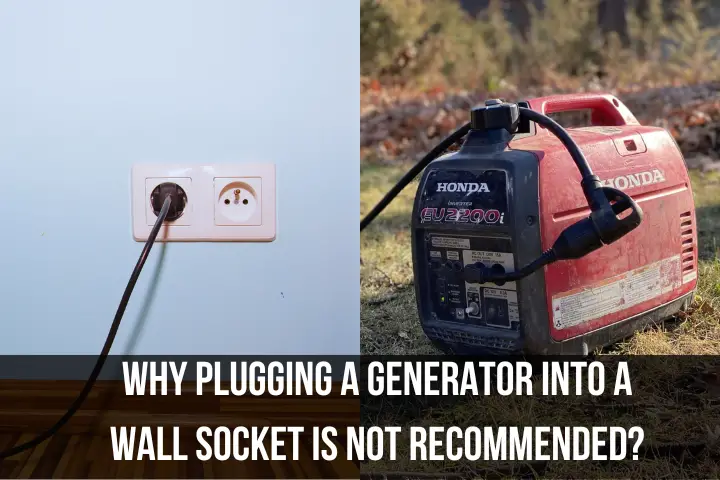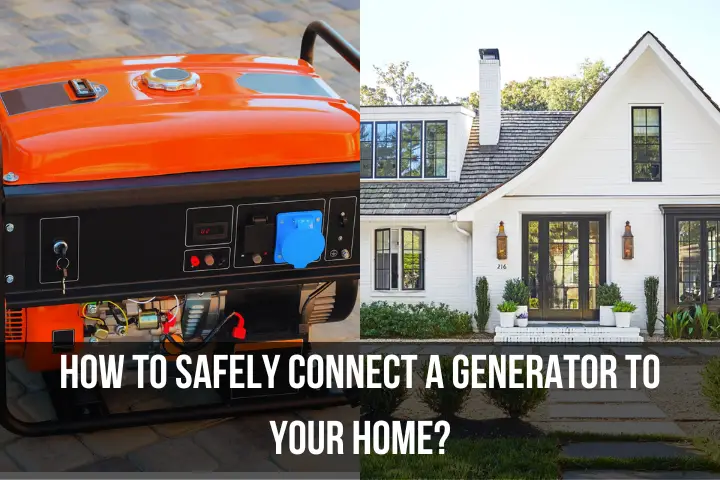If you’ve just bought a generator, you might be curious about how to connect it to your home’s power system. That’s when the idea of plugging the generator into a wall socket may cross your mind.
So, is it okay to plug a generator into a wall socket? Well, the short answer is:
Plugging any kind of generator into a wall socket is not recommended because it can become extremely dangerous. It can electrocute utility workers, damage your home’s electrical system, and even start a fire.
If you want to know how you can safely connect a generator to your home, then I have also explained it in this guide.
Keep reading!
Table of Contents
Why Plugging a Generator Into a Wall Socket is Not Recommended?

When the power goes out, and you need a backup, you must be thinking of plugging your generator into a wall socket. It might seem easy, but I want to stress that this isn’t a good idea as it’s very risky.
How? Let me explain.
Problem #01: Electrical Risks
Connecting a generator to a wall socket is a tempting thought but not something to be taken lightly. When I was researching what can happen if you plug a generator into your wall socket, I was shocked to know it can possibly cause electrical hazards.
We all know that generators “generate” a certain amount of electrical power. If you have a small portable one, it can make 3,000 watts. But if you have a bigger standby generator, it can give tens of thousands of watts (or even more).
Similarly, the electrical circuits in your home are also built to handle a specific amount of power, usually around 15 or 20 amps per circuit. However, generators can produce much higher wattage, which can overload the home’s circuits.
So, when a generator is plugged into the wall socket, this overload can result in overheating and wires melting. That’s not it. Sometimes, it can even lead to fires or harm appliances connected to those circuits.
Problem #02: Back Feeding
If you connect a generator to a wall socket, it can cause backfeeding. Back feeding happens when the generator’s electricity goes back into the main power lines. This can lead to electric shock, fires, and damage to both the generator and utility equipment.
Backfeeding happens for two main reasons:
- Wrong Connection: If you connect the generator to my home’s wiring without the right safety measures, it can make the electricity go back into the main lines.
- Safety Device Failure: Normally, a safety device called a transfer switch keeps the generator’s electricity separate from the main lines. But if you connect the generator wrong or if the transfer switch doesn’t work, there’s a risk of backfeeding.
Problem #03: Violation of NEC Standards and Laws
You’re likely breaking laws about electrical setups if you connect your generator to a wall socket. NEC (National Electrical Code) sets safety standards for electrical setups in the United States to keep everyone safe from electrical dangers and fires.
Note that NEC doesn’t allow plugging a generator into a wall socket. Not following these rules can lead to problems.
The NEC recommends using special transfer equipment like interlock kits, transfer switches, or dedicated generator outlets to safely connect a generator to the home’s electrical system.
Problem #04: Damage To Your Generator
I know generators are costly. That’s why I would suggest you should avoid anything that can damage this device. Unfortunately, plugging a generator into a wall socket can harm the generator’s electrical parts.
The reason is that connecting it to a wall socket can make electricity flow in the wrong direction, which can break the generator’s inside parts and make it stop working. That means you might end up costing a lot to fix or replace your generator.
Don’t worry; it’s easy to connect your generator without causing any trouble, and I am now about to discuss how.
How to Safely Connect a Generator to Your Home?

Safety should be your top concern while using a generator to keep your home powered. But what are the safe options? Let’s take a look at four:
- The interlock kit
- The transfer switch
- Dedicated generator outlet
- Extension cords.
Option #01: Interlock Kit
An interlock kit is a gadget that lets you connect your device (generator) to your home’s electrical system in a safe way. It does this by making sure the generator and the main utility power can’t be on at the same time. This stops backfeeding, which can lead to fire hazards.
If you want to put in an interlock kit, you usually need a licensed electrician to help. Once it’s set up, it gives you a clear and secure way to switch between generator power and regular power.
Option #02: Transfer Switch
Just like the interlock kit, a transfer switch is another safe way to connect your generator to your home. The transfer switch is put between the generator and the electrical panel, letting you choose which circuits get power from the generator.
There are two types of transfer switches: manual ones and automatic ones. Manual switches need you to do it by hand, while automatic switches can display if the power goes out and switch to generator power all on their own.
It means if there’s a power outage, the transfer switch will detect it and shift the electrical load in your home to the generator automatically.
Once regular power is back, the switch will safely shift the load back to the utility power source. It will also disconnect the generator to prevent any backfeeding.
I recommend hiring a licensed electrician for the installation of a transfer switch.
Option #03: Dedicated Generator Outlet
If you want something affordable, a dedicated generator outlet could be the way to go. This means setting up a special outlet just for your generator. It’s linked to a circuit breaker and built to handle the electrical load from your generator.
Remember, it is a temporary solution and not as “convenient” as an interlock kit or transfer switch. You will also have to handle the power source manually (which can be an extra effort).
Option #04: Extension Cords
Using extension cords should be your last resort to connect a generator. The reason is that they can work for short-term use (like a dedicated generator outlet). Plus, they are suitable for specific devices like a refrigerator or a few lights.
Here are my recommendations here:
- Remember to use heavy-duty cords meant for outdoor use and ensure they’re in good shape.
- If your generator runs inside or in a closed area, use extension cords to bring power inside while keeping the generator outside.
- I also suggest installing a carbon monoxide detector to keep an eye on the air quality indoors.
- Don’t overload the extension cords or use them in wet conditions.
- Never plug extension cords directly into regular household outlets. Instead, connect the cords to the generator’s designated outlet(s) if possible, or use a suitable outdoor-rated power distribution box.
Since that’s a lot of work, I suggest you go for the “Interlock kit” or “Transfer Switch” options.
Related: Is It Safe To Backfeed Your House With A Generator? (Illegal or Not)
Final Thoughts
All-inclusive, plugging a generator into a wall socket is not recommended because of serious electrical risks. These are electrical fires, backfeeding and violations of NEC standards (legal rules).
Fortunately, there are secure alternatives available for connecting a generator to your home’s electrical system. You can always go for options like an interlock kit, a transfer switch, or a dedicated generator outlet for a safe and proper connection.

